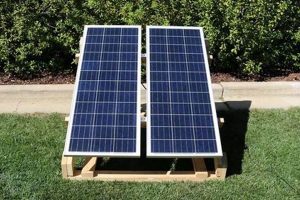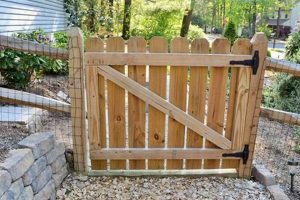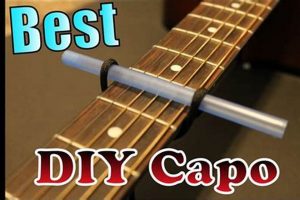A constructed luminaire designed to resemble a cumulus formation, typically incorporating light-emitting diodes (LEDs) and synthetic materials such as polyester fiberfill, provides ambient illumination. These handcrafted lighting fixtures offer a customizable and aesthetically unique alternative to conventional lighting solutions for interior spaces. An example includes a ceiling-mounted arrangement using a wire frame, adhesive, and layered fiberfill to diffuse integrated LED strip lights.
The appeal of these simulated weather phenomena lies in their ability to introduce a calming and visually interesting element to residential or commercial environments. They present an opportunity for individual creative expression and resourcefulness, often resulting in cost savings compared to commercially produced decorative lighting. Historically, the creation of such items reflects a broader trend toward personalized and sustainable design practices, leveraging readily available materials.
The subsequent sections will elaborate on specific construction techniques, material selection considerations, and optimal application scenarios for these handcrafted lighting solutions, providing a comprehensive guide to their creation and integration within various interior design schemes.
Construction Considerations
The following guidelines provide essential considerations for the successful fabrication of an artificial cloud luminaire. Adherence to these recommendations will contribute to a structurally sound and visually appealing result.
Tip 1: Material Selection: Opt for flame-retardant polyester fiberfill to mitigate fire hazards. Verify that the chosen adhesive is compatible with both the base material of the frame and the fiberfill, ensuring a secure and lasting bond.
Tip 2: Frame Construction: Employ a rigid frame, such as wire mesh or a lightweight plastic structure, to provide adequate support for the fiberfill. The frame’s design should facilitate even distribution of the light source and prevent sagging.
Tip 3: Illumination Source: Utilize low-voltage LED strip lights to minimize heat generation and energy consumption. The color temperature of the LEDs should be carefully selected to achieve the desired ambiance, ranging from warm white to cool white, depending on the intended application.
Tip 4: Layering Technique: Apply the fiberfill in thin, overlapping layers to create a realistic cloud-like texture. Avoid excessive clumping, which can obstruct light diffusion and detract from the aesthetic appeal.
Tip 5: Power Supply Considerations: Ensure that the power supply for the LED strip lights is properly sized and compliant with relevant safety standards. Conceal the power supply within the structure or mount it externally to maintain a clean appearance.
Tip 6: Ventilation: Incorporate adequate ventilation to prevent heat buildup within the structure, particularly if enclosed. This can be achieved through strategically placed openings or the use of a heat sink for the LED driver.
The successful creation of a durable and visually pleasing artificial cloud luminaire relies on careful material selection, meticulous construction techniques, and adherence to safety protocols. By prioritizing these aspects, a high-quality lighting fixture can be achieved.
The subsequent sections will delve into optimal placement strategies and integration possibilities within various interior design contexts, further enhancing the utility and aesthetic value of this handcrafted lighting solution.
1. Realistic Fiber Density
Realistic fiber density is a pivotal attribute in the construction of simulated meteorological luminaires, directly influencing the aesthetic realism and luminous properties of the finished product. Accurate replication of cloud-like texture requires careful manipulation of material distribution to achieve optimal light diffusion and visual appeal.
- Achieving Authentic Texture
The primary role of appropriate fiber density is to simulate the irregular and amorphous texture of natural clouds. Insufficient density results in a sparse, unnatural appearance, while excessive density diminishes light transmission and creates an opaque, unrealistic effect. For example, loosely packed, thin layers of polyester fiberfill are more effective than densely packed clumps in mimicking the translucent quality of clouds. Improper density negates the goal of creating a visually compelling simulation.
- Optimizing Light Diffusion
The density of the fibrous material directly affects the way light is diffused throughout the structure. A carefully calibrated density ensures even distribution of illumination, avoiding hotspots and creating a soft, ambient glow. Regions with overly dense fiber hinder light passage, leading to dark patches. Conversely, excessively sparse regions produce bright, uneven illumination. Balanced density is crucial for emulating the natural light diffusion properties of clouds. LEDs integrated in the system must be consider too with its color temperature and strength.
- Material Consumption and Cost Efficiency
Precise control over fiber density is integral to maximizing material efficiency and minimizing project costs. Overuse of fiberfill to compensate for inadequate construction techniques inflates material expenses unnecessarily. By employing a strategic layering approach and carefully adjusting fiber distribution, a realistic visual outcome can be achieved with minimal material waste. Implementing best practices is more economical than a poor plan.
- Structural Integrity and Longevity
Fiber density impacts the structural integrity of the cloud structure. Overly dense packing may place undue stress on the supporting frame, potentially leading to deformation or collapse over time. Conversely, sparse packing offers inadequate support, increasing the risk of sagging or detachment. Achieving optimal fiber density contributes to the overall durability and longevity of the lighting fixture, ensuring long-term performance and aesthetic preservation. The support needs to be strong enough to withstand the weight of the fiber with the adhesive.
In summary, fiber density is a critical parameter impacting the realism, luminosity, cost-effectiveness, and structural integrity of a cloud luminaire. Therefore, careful consideration must be given to this attribute during the design and construction phases to ensure a high-quality, visually compelling, and durable lighting fixture. All facets must be considered prior to construction.
2. Safe LED Wattage
The selection of an appropriate LED wattage is paramount in the construction of artificial cloud luminaires, directly influencing operational safety, thermal management, and overall lifespan of the lighting system. Implementing saf
e LED wattage is critical to prevent fire hazards, component failure, and compromised performance.
- Fire Hazard Mitigation
Employing LEDs with excessive wattage can lead to overheating, thereby increasing the risk of igniting flammable materials used in the cloud construction, such as polyester fiberfill. The selection of low-wattage LEDs, typically 5W or less per strip, minimizes thermal output and reduces the potential for combustion. For instance, using a 12V LED strip with a power consumption of 4.8W per meter ensures a lower surface temperature compared to a higher wattage alternative, enhancing safety.
- Thermal Management and Component Lifespan
Operating LEDs at or below their rated wattage extends their operational lifespan and prevents premature failure. Overdriven LEDs generate excessive heat, which accelerates degradation of the semiconductor junction and reduces light output over time. Implementing adequate heat dissipation measures, such as aluminum heat sinks or properly ventilated enclosures, further mitigates thermal stress and prolongs component life. A 5050 LED operating at its maximum rated current without proper heat sinking will experience significantly reduced lifespan and lumen output compared to operation within safe thermal limits.
- Power Supply Compatibility
Ensuring compatibility between the LED wattage and the power supply’s capacity is essential for stable and reliable operation. Overloading a power supply can lead to voltage drops, flickering, and eventual failure. Selecting a power supply with sufficient headroom, typically 20-30% above the total LED wattage, ensures stable voltage regulation and prevents excessive strain on the power supply components. For example, a cloud luminaire utilizing 20W of LED strips requires a power supply rated for at least 24W to accommodate voltage fluctuations and prevent overheating.
- Energy Efficiency and Operational Costs
Selecting LEDs with appropriate wattage optimizes energy consumption and minimizes operational costs. Lower wattage LEDs generally exhibit higher energy efficiency, converting a larger proportion of electrical energy into light rather than heat. Employing efficient LEDs reduces the overall power consumption of the cloud luminaire, resulting in lower electricity bills and reduced environmental impact. Using LEDs with a luminous efficacy of 100 lumens per watt, compared to 50 lumens per watt, yields a significant reduction in energy consumption for the same light output.
In conclusion, the careful selection of safe LED wattage is a critical factor in ensuring the safety, reliability, longevity, and energy efficiency of artificial cloud luminaires. Prioritizing these considerations during the design and construction phases leads to a well-performing and sustainable lighting solution. Moreover, adherence to safety standards and best practices is paramount to prevent hazards and ensure user safety.
3. Secure Frame Structure
A stable and robust frame constitutes a foundational element in the construction of artificial cloud luminaires, directly influencing the structural integrity, longevity, and overall aesthetic of the finished product. The selection and assembly of a secure frame directly mitigate risks associated with sagging, deformation, or complete structural failure, ensuring the luminaire maintains its intended form and function over time. For example, a lightweight wire mesh frame, properly reinforced at stress points, provides a rigid support system for the fiberfill and lighting components, preventing deformation under the weight of the applied materials. Inadequate frame construction inevitably leads to premature degradation of the luminaire’s appearance and functionality.
The connection between a secure frame structure and the completed luminaire is further underscored by the necessity of proper load distribution. The weight of the fiberfill, lighting elements, and any additional decorative components must be evenly distributed across the frame to prevent localized stress concentrations. This can be achieved through careful design of the frame geometry and strategic attachment points for the covering materials. An example involves utilizing a geodesic dome structure as a frame, distributing weight uniformly and providing exceptional structural stability, even with substantial material loading. Without adequate load distribution, frame failure becomes increasingly likely, particularly in larger or more complex designs.
In summary, a secure frame structure is not merely a supporting element, but an integral component that dictates the long-term viability and aesthetic appeal of artificial cloud luminaires. The careful selection of materials, meticulous assembly techniques, and attention to load distribution are all critical factors in achieving a durable and visually pleasing lighting fixture. Neglecting the importance of a secure frame structure compromises the entire project, rendering any other design or construction efforts ultimately unsustainable.
4. Uniform Light Diffusion
Uniform light diffusion is a critical attribute in the design and construction of artificial cloud luminaires. Achieving a consistent distribution of light throughout the cloud structure is essential for creating a visually appealing and realistic simulation of natural cloud formations.
- Material Selection and Light Transmission
The choice of materials significantly impacts the uniformity of light diffusion. Materials with high light transmission properties, such as translucent polyester fiberfill, are preferred to minimize light absorption and ensure even distribution. The density and layering of the material must be carefully controlled to avoid localized hotspots or dark spots. For instance, unevenly distributed fiberfill results in non-uniform light patterns, undermining the realism of the simulated cloud.
- Light Source Characteristics and Placement
The type and placement of the light source influence the uniformity of light diffusion. Diffuse light sources, such as LED strip lights with closely spaced LEDs, are generally preferred over point sources to minimize glare and create a more even distribution of light. Strategic placement of the light source within the cloud structure ensures that light reaches all areas, preventing shadows and uneven illumination. For example, placing a single, bright LED in the center of a cloud structure often creates a noticeable hotspot, while distributing several lower-intensity LEDs throughout the structure promotes uniform diffusion.
- Structural Design and Internal Reflection
The internal structure of the artificial cloud can be designed to promote uniform light diffusion through reflection and scattering. Reflective surfaces strategically placed within the cloud structure redirect light to areas that would otherwise be poorly illuminated. This can be achieved by lining the inside of the frame with reflective material or incorporating small, reflective elements within the fiberfill. For example, a cloud structure with a matte white interior surface scatters light more effectively than a structure with a dark or absorptive interior, leading to more uniform illumination.
- Distance and Viewing Angle Considerations
The perceived uniformity of light diffu
sion is influenced by the distance and viewing angle. A cloud luminaire that appears uniformly lit from a distance may exhibit uneven illumination upon closer inspection. The design should account for the typical viewing distance and angle to optimize perceived uniformity. For instance, a cloud structure designed to be viewed from across a room may require less attention to fine-scale diffusion than a structure intended for close-up viewing.
In conclusion, achieving uniform light diffusion in artificial cloud luminaires requires careful consideration of material properties, light source characteristics, structural design, and viewing conditions. Optimizing these factors leads to a visually compelling and realistic simulation of natural cloud formations, enhancing the aesthetic appeal and functionality of the lighting fixture. The balance between these aspects is critical in realizing a successful implementation within diverse interior spaces.
5. Durable Adhesive Bond
The longevity and structural integrity of handcrafted cloud-simulating luminaires are critically dependent upon the creation and maintenance of a durable adhesive bond between constituent materials. This adhesive bond directly affects the fixture’s ability to withstand environmental stresses and maintain its aesthetic form over time.
- Material Compatibility and Bond Strength
Adhesive selection must prioritize compatibility with both the frame material (e.g., metal, plastic) and the cloud simulation material (typically polyester fiberfill). Incompatible adhesives may exhibit poor adhesion, leading to material delamination and structural failure. A robust adhesive, such as a high-grade construction adhesive or a specialized fabric adhesive, ensures a strong and lasting bond capable of withstanding tensile and shear forces. For instance, using a general-purpose craft glue on a metal frame may result in bond failure due to differential expansion and contraction of the materials with temperature changes. The adhesive need to be considered depending on climate.
- Environmental Resistance and Degradation
Adhesive degradation due to environmental factors, such as humidity, temperature fluctuations, and UV exposure, presents a significant threat to the long-term stability of the fixture. Adhesives with inherent resistance to these elements are preferred. For example, a moisture-resistant adhesive prevents bond weakening and fiber detachment in humid environments, while a UV-resistant adhesive prevents yellowing and embrittlement from prolonged exposure to sunlight. Neglecting environmental resistance considerations reduces the adhesive’s lifespan and compromises the fixture’s structural integrity, resulting in both aesthetic and functional decline.
- Application Technique and Coverage
Proper adhesive application is as crucial as adhesive selection. Insufficient adhesive coverage or improper application techniques, such as applying excessive pressure or failing to clean surfaces prior to application, weakens the bond and increases the likelihood of failure. Achieving uniform coverage and allowing adequate curing time are essential for maximizing bond strength and durability. For example, applying adhesive in intermittent dabs rather than a continuous bead reduces bond strength and creates points of vulnerability. Proper application techniques minimize stress concentrations and ensure a more robust adhesive joint.
- Long-Term Creep and Stress Relaxation
Over time, adhesives are subject to creep and stress relaxation, phenomena that can compromise bond strength and structural integrity. Selecting adhesives with low creep characteristics minimizes deformation and prevents bond weakening under sustained loads. Additionally, designing the fixture to minimize stress concentrations on the adhesive bond helps to mitigate the effects of creep and stress relaxation. For instance, a design that evenly distributes the weight of the fiberfill across the frame reduces stress on the adhesive joints, extending the lifespan of the bond.
The durable adhesive bond is a crucial, albeit often overlooked, element in the design and construction of these luminaires. By prioritizing material compatibility, environmental resistance, proper application techniques, and long-term stability, a resilient and aesthetically pleasing fixture can be realized. Conversely, neglecting these considerations leads to premature failure and compromises the overall value of the project. Therefore, the adhesive bond must be given careful consideration alongside other design and construction parameters.
6. Controlled Heat Dissipation
Effective regulation of thermal output within constructed cloud luminaires is a critical design parameter directly impacting operational safety, longevity, and overall performance. Inadequate heat dissipation from light-emitting diode (LED) sources housed within the enclosed structure can lead to elevated temperatures, potentially igniting flammable materials such as polyester fiberfill commonly employed in these projects. This presents a significant fire hazard, necessitating the implementation of effective heat management strategies. The operational lifespan and luminous efficacy of LEDs are also inversely proportional to their operating temperature. Elevated temperatures accelerate degradation of the semiconductor junction, resulting in reduced light output and premature component failure. Therefore, controlled heat dissipation is not merely a safety consideration but a crucial factor in ensuring the sustained functionality and economic viability of constructed cloud luminaires.
Practical implementation of controlled heat dissipation can be achieved through several methods. Passive cooling techniques, such as the utilization of aluminum heat sinks attached to the LED strips, facilitate the conduction of heat away from the light source and into the surrounding air. Active cooling methods, such as the incorporation of small, low-noise fans, enhance convective heat transfer, further reducing the operating temperature of the LEDs. The design of the luminaire structure itself can also contribute to heat dissipation. Incorporating ventilation openings allows for the free flow of air, preventing the buildup of heat within the enclosed volume. Careful consideration must also be given to the power supply. Overloading the power supply generates additional heat, exacerbating the problem. Selection of an appropriately rated power supply, with sufficient headroom to accommodate voltage fluctuations and prevent overheating, is essential.
In summary, controlled heat dissipation is a non-negotiable design consideration in the creation of simulated cloud luminaires. The implementation of effective heat management strategies, through passive or active cooling methods, is essential for ensuring operational safety, maximizing component lifespan, and maintaining optimal performance. Failure to address thermal management adequately introduces unacceptable risks and compromises the long-term viability of the lighting solution. Adherence to established safety standards and best practices in thermal management is therefore paramount in the construction and operation of these luminaires.
7. Aesthetic Customization Options
The incorporation of individualized aesthetic elements is a significant facet of constructed cloud luminaires, offering opportunities for personal expression and design integration within diverse environments. The ability to modify the visual characteristics of these lighting fixtures directly impacts their suitability for specific architectural styles and individual preferences.
- Shape and Form Alteration
The fundamental silhouette of simulated cloud structures can be manipulated to achieve varied visual effects. Deviation from traditional cumulus-inspired forms allows for the creation of abstract or geometric designs, aligning the luminaire with contemporary interior aesthetics. For example, a rectangular frame can be employed to emulate a lenticular cloud formation, diverging from the rounded contours of typical cloud representations. The shape must align with the style of the home.
- Color Temperature Modulation
Adjusting the color temperature of the integrated light source profoundly affects the perceived ambiance and emotional impact of the luminaire. Warmer color temperatures (e.g., 2700K) evoke a sense of tranquility and intimacy, while cooler temperatures (e.g., 6500K) promote alertness and clarity. The selection of variable-color LED strips enables dynamic modulation of color temperature, allowing users to tailor the lighting to specific activities or moods. The color temperature should align with the needs of the lighting needed in the home.
- Surface Texture Enhancement
Modifying the surface texture of the fiberfill material can introduce subtle variations in light diffusion and visual interest. Techniques such as airbrushing with diluted acrylic paints or incorporating iridescent fibers add depth and complexity to the cloud surface. The application of subtle shading creates a more three-dimensional appearance, enhancing the realism of the simulated cloud formation. This can be customized per preferences.
- Integration of Decorative Elements
The incorporation of external decorative elements provides further opportunities for aesthetic customization. Attaching small, lightweight objects such as artificial foliage, miniature figurines, or reflective sequins enhances the visual complexity and thematic resonance of the luminaire. The selection of these elements should complement the overall design scheme of the interior space. These elements should not be flammable.
These customization facets, when strategically implemented, transform a basic cloud luminaire into a personalized design element, seamlessly integrating into the intended environment and reflecting the individual preferences of the occupant. These facets enable individuals to create a signature lighting solution tailored to their unique aesthetic sensibilities.
Frequently Asked Questions
The following section addresses common inquiries and misconceptions regarding the construction, operation, and safety of artificial cloud luminaires. These answers aim to provide clarity and guidance based on established principles and best practices.
Question 1: What constitutes the primary fire hazard associated with constructed cloud luminaires?
The primary fire hazard stems from the potential ignition of flammable materials, particularly polyester fiberfill, due to overheating of inadequately cooled light-emitting diode (LED) sources. Insufficient heat dissipation and the use of excessive LED wattage significantly elevate this risk.
Question 2: How does LED wattage influence the operational lifespan of cloud luminaires?
Excessive LED wattage, leading to elevated operating temperatures, accelerates degradation of the semiconductor junction, resulting in reduced light output and premature component failure. The use of appropriately rated, low-wattage LEDs and effective heat dissipation techniques are crucial for maximizing longevity.
Question 3: What considerations are paramount in selecting an appropriate adhesive for cloud luminaire construction?
Adhesive selection must prioritize compatibility with both the frame material and the cloud simulation material, environmental resistance (humidity, UV exposure), and long-term creep resistance. A robust, high-quality adhesive is essential for ensuring structural integrity and preventing material delamination.
Question 4: How does fiber density impact the visual appeal and light diffusion of cloud luminaires?
Appropriate fiber density is crucial for achieving a realistic cloud-like texture and uniform light diffusion. Insufficient density results in a sparse, unnatural appearance, while excessive density diminishes light transmission and creates an opaque effect. A carefully calibrated density ensures even illumination and a visually compelling simulation.
Question 5: What is the recommended method for achieving uniform light distribution within cloud luminaires?
Uniform light distribution is best achieved through the strategic placement of diffuse light sources, such as closely spaced LED strip lights, and the incorporation of reflective surfaces within the cloud structure to redirect light to areas that would otherwise be poorly illuminated.
Question 6: How can users ensure the structural integrity and prevent sagging of constructed cloud luminaires?
Ensuring structural integrity requires the use of a rigid frame, such as wire mesh or a lightweight plastic structure, proper load distribution to prevent localized stress concentrations, and careful selection of materials with adequate strength and durability. Proper frame construction and material selection are essential for preventing sagging and maintaining the intended form over time.
In summary, the successful construction and operation of artificial cloud luminaires necessitate careful consideration of safety, material selection, construction techniques, and design parameters. Adherence to established best practices is paramount for achieving a durable, aesthetically pleasing, and safe lighting solution.
The subsequent sections will explore advanced customization options and innovative applications of constructed cloud luminaires, further expanding the possibilities for creative lighting design.
Conclusion
The preceding analysis has elucidated the multifaceted considerations inherent in the creation of a “diy cloud light.” From meticulous material selection to stringent safety protocols, the successful execution of such a project demands a comprehensive understanding of both aesthetic principles and practical engineering. Key aspects, including heat dissipation, adhesive durability, and light diffusion, are not merely cosmetic enhancements but critical determinants of the luminaire’s long-term viability and operational integrity.
The creation of a “diy cloud light” represents a confluence of creativity and technical acumen. As individuals embark on this endeavor, they are encouraged to prioritize safety, informed decision-making, and a commitment to quality craftsmanship. The enduring value of these lighting solutions lies not only in their visual appeal but also in their embodiment of responsible design practices. The future evolution of these fixtures will likely emphasize sustainable materials and enhanced energy efficiency, further solidifying their role as both functional art and environmentally conscious lighting alternatives.







